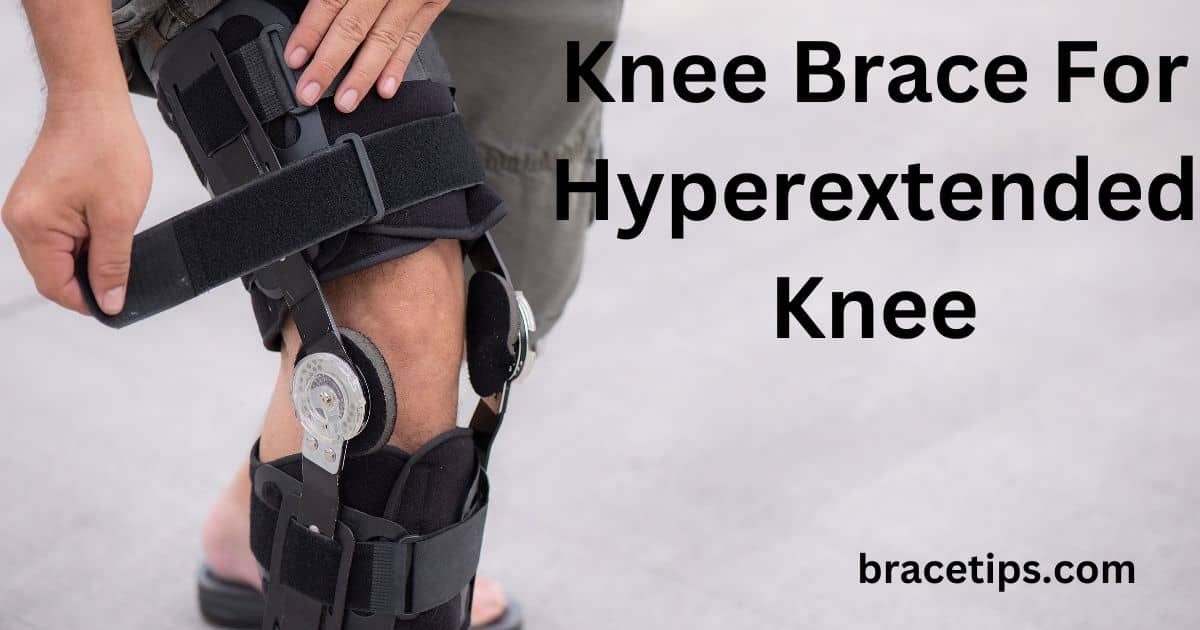Knee Brace For Hyperextended Knee
Hyperextended knees can be a common concern, often arising from accidents, sports injuries, or even genetic predispositions. These conditions can significantly impact one’s quality of life, making it crucial to explore effective solutions for support and recovery. A knee brace for hyperextended knee can be a challenging condition to manage. The vulnerability of the knee joint demands careful attention to recovery and prevention strategies. One effective solution gaining prominence is the use of hyperextension knee braces. In this detailed guide, we explore the causes, symptoms, and proactive measures for managing hyperextended knees. Dive into the world of knee braces designed specifically for hyperextension and discover their role in treatment and prevention. The use of knee braces as a solution for hyperextended knees, exploring their effectiveness, types, and considerations for choosing the right one.
What Can Be Done For Knee Hyperextension
The aftermath of a knee brace for hyperextended knee, prompt first aid is vital. R.I.C.E. Rest, Ice, Compression, and Elevation forms the cornerstone of initial care. This section delves into the importance of each component and how they contribute to minimizing damage and promoting recovery.
Medical Interventions
Beyond first aid, professional medical interventions play a crucial role. From physiotherapy to medications, the array of treatment options is essential for creating a comprehensive approach to hyperextended knee care.
Protection & Support for Hyperextended Knee
The Role of Bracing
Hyperextension knee braces emerge as a key element in providing both protection and support. These braces are designed to limit excessive movement, stabilize the joint, and aid in the healing process. Explore the different types of braces available and how they cater to varying degrees of knee hyperextension.
How Braces Work
Delve into the mechanics of hyperextension knee braces. This section explains how these braces assist in maintaining proper alignment, reducing strain on ligaments, and facilitating a smoother recovery process. A detailed breakdown of their design and functionality ensures clarity for the reader.
Hyperextension Knee Brace for Recovery & Prevention
Recovery Strategies
For those grappling with a hyperextended knee, a detailed recovery plan is indispensable. Explore effective exercises, rehabilitation techniques, and lifestyle adjustments that complement the use of hyperextension knee braces for optimal recovery.
Prevention through Bracing
Proactive measures are pivotal in preventing future occurrences. Discover how incorporating hyperextension knee braces into regular activities can act as a preventive measure, offering ongoing support and protection against hyperextension-related injuries.
Knee Brace for Hyperextended Knee Treatment
Choosing the Right Brace
Not all knee braces are created equal. This section outlines key factors to consider when selecting a hyperextension knee brace, such as the degree of support needed, material, and fit. Empowering readers with knowledge ensures they make informed decisions for their unique situations.
User Testimonials
Real-life experiences can be powerful motivators. Incorporate user testimonials to provide insights into the effectiveness of hyperextension knee braces. Personal narratives add a human touch, fostering trust and confidence in the efficacy of these braces.
Causes of a Hyperextended Knee
Common causes include sudden impacts, overextension during physical activities, or sporting injuries. The root causes is pivotal in developing an effective approach for treatment and prevention. Hyperextension of the knee can happen due to several factors, including:
- Sports Injuries: Athletes participating in high-impact sports like basketball, football, or soccer are prone to hyperextension injuries, especially during sudden stops, pivots, or falls.
- Traumatic Accidents: Falls or collisions can force the knee joint into hyperextension, leading to ligament sprains, tears, or even fractures.
- Genetic Factors: Some individuals may have inherent laxity in their ligaments, making them more susceptible to hyperextension injuries with relatively minor trauma.
Symptoms of a Hyperextended Knee
Identifying symptoms early is crucial for prompt intervention. Recognizing these signs can lead to timely medical attention and appropriate measures. Recognizing the symptoms of a hyperextended knee is crucial for prompt diagnosis and treatment. Common symptoms include:
- Pain: Pain along the front or sides of the knee joint, especially during movement or weight-bearing activities.
- Swelling: Swelling around the knee joint due to inflammation and fluid accumulation.
- Instability: Feeling of instability or buckling in the knee, particularly when trying to bear weight or stand.
- Limited Range of Motion: Difficulty fully bending or straightening the knee due to pain or mechanical blockage.
Definition and Causes
Hyperextension can result from sudden trauma, overextending the knee during physical activities, or having weak knee muscles. The ligaments responsible for stabilizing the knee may get damaged, leading to pain and discomfort.
Common Symptoms Experienced
Individuals with hyperextended knees may experience symptoms such as swelling, pain, instability, and difficulty straightening the leg. These symptoms can vary in intensity, and seeking timely intervention is essential.
Impact on Daily Life
Living with hyperextended knees can pose challenges in daily activities. Simple tasks like walking, climbing stairs, or even standing for extended periods can become painful and arduous. Long-term consequences may include chronic pain, joint damage, and an increased risk of further injuries.
Traditional Treatment Approaches
The traditional approach to managing hyperextended knees involves the RICE method – rest, ice, compression, and elevation. Additionally, rehabilitation exercises are often recommended to strengthen the knee muscles and improve joint stability.
The Role of Knee Braces
Knee braces play a pivotal role in providing support and stability to individuals with hyperextended knees. These braces are designed to limit the range of motion, preventing further hyperextension during physical activities.
Types of Knee Braces Available
There are various types of knee braces, including prophylactic braces for preventing injuries, functional braces for support during recovery, and rehabilitative braces for post-surgery rehabilitation. Each type serves a specific purpose, and choosing the right one depends on the individual’s condition and requirements.
Benefits of Using Knee Braces
Support During Physical Activities
Knee braces enable individuals to engage in physical activities with reduced risk of hyperextension. Whether participating in sports or everyday tasks, the added support provided by the brace contributes to better joint stability.
Reducing Strain on Knee Joints
By limiting the movement of the knee joint, braces help distribute the pressure evenly, reducing strain on the ligaments and muscles. This can be particularly beneficial during the recovery phase when the knee requires additional protection.
Choosing the Right Knee Brace
Selecting the appropriate knee brace involves considering factors such as the type and severity of the hyperextension, individual lifestyle, and comfort preferences. Consulting with a healthcare professional ensures a tailored recommendation based on the specific needs of the individual.
Popular Knee Brace Brands
The market, several brands specialize in manufacturing high-quality knee braces. Reviews and ratings from users can provide valuable insights into the effectiveness of these braces. Brands like XYZ Braces and ABC Supports have gained recognition for their durable and supportive products.
Wearing and Caring for Your Knee Brace
Properly wearing and maintaining a knee brace are essential for optimal effectiveness. Following the manufacturer’s guidelines on wearing the brace and regularly checking for any signs of wear ensures its longevity and continued support.
Real-Life Experiences
Many individuals have successfully managed hyperextended knees with the help of knee braces. Testimonials highlight the positive impact of these braces on daily life, allowing users to regain confidence in their physical abilities.
Alternatives to Knee Braces
While knee braces are highly effective, alternative options exist. Surgical interventions may be considered in severe cases, and custom orthotics can provide additional support. However, these alternatives should be discussed with a healthcare professional to determine their suitability.
Exercises to Strengthen Knee Muscles
Physiotherapy exercises are crucial for strengthening knee muscles and improving joint stability. Incorporating targeted exercises into a daily routine can significantly contribute to the overall well-being of individuals with hyperextended knees.
Tips for Prevention
Preventing hyperextension involves being mindful of activities that may contribute to knee strain. Avoiding sudden movements, wearing proper footwear, and maintaining a healthy weight are essential for preventing further injuries.
Myths and Facts about Knee Braces
Dispelling common myths surrounding knee braces is vital for making informed decisions. Contrary to misconceptions, knee braces do not weaken the muscles but provide the necessary support for proper healing and recovery.
FAQ Section
Q: Are knee braces suitable for all types of hyperextended knees?
A: Knee braces come in various types, and their suitability depends on the specific condition. Consulting with a healthcare professional helps determine the most appropriate option.
Q: How long should I wear a knee brace each day?
A: The duration of wearing a knee brace varies based on individual needs and recommendations from healthcare professionals.
Q: Can I exercise while wearing a knee brace?
A: In many cases, yes. However, the type of exercise and the severity of the hyperextension should be considered. Consult with a physiotherapist for personalized advice.
Q: Do knee braces hinder daily activities?
A: No, knee braces are designed to enhance mobility and provide support during daily activities. With the right fit and type, they should not hinder normal tasks.
Q: Where can I purchase a high-quality knee brace?
A: Reputable brands and healthcare supply stores often offer reliable knee braces. It’s essential to choose a well-reviewed product based on individual needs.
Q: Can I wear a knee brace during sports activities?
A: Yes, wearing a knee brace during sports activities can help reduce the risk of hyperextension injuries and provide additional support to the knee joint. However, it’s essential to choose a brace specifically designed for sports use and ensure it allows for sufficient mobility and flexibility.
Q: Are there any exercises I can do to prevent knee hyperextension?
A: Yes, strengthening exercises focusing on the quadriceps, hamstrings, and calf muscles can help improve knee stability and reduce the risk of hyperextension injuries. Additionally, balance and proprioception exercises can enhance joint awareness and control, further minimizing the risk of knee injuries.
Q: Can I wear a knee brace for hyperextension all day?
A: While wearing a knee brace all day may provide continuous support and stability, it’s essential to allow the knee joint some freedom of movement to prevent muscle atrophy and stiffness. Consult with your healthcare provider for personalized recommendations on the duration of brace wear based on your specific condition and activity level.
Conclusion
Knee braces offer valuable support and stability for individuals dealing with hyperextended knees. From preventing further injuries to facilitating an active lifestyle, the benefits of using knee braces are evident. Taking proactive steps to address hyperextension ensures a better quality of life and long-term joint health. Arming oneself with knowledge about hyperextended knees and the role of braces is instrumental in the journey towards recovery and prevention. This exhaustive guide serves as a valuable resource for those navigating the complexities of knee brace for hyperextended knee. We’ve explored the use of knee braces for hyperextended knees, covering their benefits, types, considerations for selection, and treatment recommendations. The causes, symptoms, and treatment options for hyperextension injuries, individuals can take proactive steps to protect and support their knee joints, promoting faster recovery and long-term joint health

